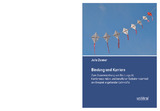Citation link:
http://dx.doi.org/10.25819/ubsi/1890Files in This Item:
| File | Description | Size | Format | |
|---|---|---|---|---|
| Zenner_Dissertation_Bindung und Karriere_Komplett.pdf | 16.27 MB | Adobe PDF |  View/Open |
| Dokument Type: | Doctoral Thesis | metadata.dc.title: | Bindung und Karriere – Zum Zusammenhang von Bindungsstil, Karriereaspiration und beruflicher Selbstwirksamkeit am Beispiel angehender Lehrkräfte | Other Titles: | Attachment and career – A research on the relationship between attachment style, career aspiration and vocational self-efficacy using the example of teacher education candidates | Authors: | Zenner, Julie | Institute: | Fakultät II (Bildung, Architektur, Künste) | Free keywords: | Bindung, Karriereaspiration, Selbstwirksamkeit, angehende Lehrkräfte, attachment, career aspiration, self-efficacy, teacher, education candidates | Dewey Decimal Classification: | 320 | GHBS-Clases: | IJB ICI |
Issue Date: | 2020 | Publish Date: | 2020 | Source: | Siegen: universi - Universitätsverlag Siegen, 2020. - ISBN 978-3-96182-066-5 | Abstract: | Das zentrale Anliegen dieser Arbeit war die Untersuchung des Zusammenhangs zwischen dem Bindungsstil eines Menschen und seiner Karriereaspiration sowie die Analyse der Bedeutung der beruflichen Selbstwirksamkeit für diesen Zusammenhang. Die Überprüfung erfolgte anhand einer Stichprobe angehender Lehrkräfte. Das theoretische Fundament für die Untersuchung bildeten die Bindungstheorie (Bowlby, 2006a, 2006b, 2006c) und die sozial-kognitive Laufbahntheorie (Lent, Brown & Hackett, 1994). Letztere liefert mit dem Modell der Karrierewahl ein Rahmenmodell zur Begründung des Zusammenhangs zwischen personenbezogenen Faktoren und Karriereaspiration. Ein untergeordnetes Ziel der Arbeit bestand darin, zu überprüfen, inwiefern der Bindungsstil in diesem Modell als personenbezogener Input-Faktor berücksichtigt werden kann und sollte. Die Untersuchung stützte sich auf die Daten von insgesamt 381 Bachelorstudierenden und 514 Referendaren des Lehramts. Für beide Kohorten wurden jeweils zwei hierarchisch geschachtelte Strukturgleichungsmodelle (Primär- und Alternativmodell) geprüft. Der Bindungsstil, mit den zwei Dimensionen Vermeidung und Ängstlichkeit, wurde mit dem Bochumer Bindungsfragebogen (BoBi; Neumann, Rohmann & Bierhoff, 2007) operationalisiert. Die Karriereaspiration, mit den vier Bereichen geplante Anstrengung, geplante Ausdauer, Weiterbildungsaspiration und Führungsaspiration, wurde mit der deutschen Übersetzung des Instruments Professional Engagement and Career Development Aspiration Scale (PECDA; Watt & Richardson, 2008) gemessen. Als berufliche Form der Selbstwirksamkeit fand die Lehrerselbstwirksamkeit Betrachtung, gemessen mit der deutschen Version des Instruments Scale for Teacher Self-Efficacy (STSE; Pfitzner- Eden, 2015). Bei den Referendaren wies das Primärmodell die bessere Passung zu den Daten auf: Zwischen den beiden Bindungsdimensionen und der Lehrerselbstwirksamkeit zeigten sich direkte negative Effekte und zwischen der Lehrerselbstwirksamkeit und den vier Bereichen der Karriereaspiration zeigten sich direkte positive Effekte. Der Zusammenhang zwischen Bindungsstil und Karriereaspiration wurde dabei vollständig durch die Lehrerselbstwirksamkeit mediiert. Bei den Studierenden zeigten sich dagegen keine eindeutigen Ergebnisse. Insgesamt konnte die Relevanz des Bindungsstils als personenbezogener Input-Faktor im Modell der Karrierewahl bestätigt werden. Die theoretische und praktische Bedeutung der Ergebnisse wie auch deren Limitationen werden diskutiert. The main objective of the present research was to examine the relationship between a person’s attachment style and his or her career aspiration and to analyze the importance of his or her vocational self-efficacy for this relationship. This was performed by means of a sample of teacher education candidates. Attachment theory (Bowlby, 2006a, 2006b, 2006c) and social-cognitive career theory (Lent, Brown & Hackett, 1994) were used as the underlying theoretical concepts. The latter provides with its model of career choice a framework model supporting the existence of a relationship between personality related variables and career aspiration. A subordinate objective of the present research was to examine to which extent attachment style could be and should be considered as a personality related variable in this model. The study is based on the data of a total of 381 students (bachelor degree) and 514 pre-service teachers in traineeship. Using structural equation modeling, two competing hierarchical / nestled models (primary structural model and alternative structural model) were tested for both of the cohorts. Attachment style, with its two dimensions avoidance and anxiety, was assessed utilizing the Bochumer Bindungsfragebogen Scale (BoBi; Neumann, Rohmann & Bierhoff, 2007). Career aspiration with its four domains planned effort, planned persistence, professional development aspiration and leadership aspiration was assessed with the German version of the Professional Engagement and Career Development Aspiration Scale (PECDA; Watt & Richardson, 2008). Teachers self-efficacy, as a specific form of vocational self-efficacy, was measured using the German version of the Scale for Teacher Self-Efficacy (STSE; Pfitzner-Eden, 2015). For the cohort of pre-service teachers in traineeship the primary model best fit the data, finding direct negative effects between the two attachment dimensions and teacher self-efficacy as well as direct positive effects between teacher self-efficacy and the four domains of career aspiration. The relationship between attachment style and career aspiration was completely mediated by the variable of teacher self-efficacy. For the cohort of students results did not allow to draw a clear conclusion. Overall, the present research confirmed the relevance of the attachment style as a personality related variable within the model of career choice. Theoretical and practical implications of the results, as well as their limitations are discussed. |
DOI: | http://dx.doi.org/10.25819/ubsi/1890 | URN: | urn:nbn:de:hbz:467-16026 | URI: | https://dspace.ub.uni-siegen.de/handle/ubsi/1602 | License: | http://creativecommons.org/licenses/by-sa/4.0/ |
| Appears in Collections: | Universi Hochschulschriften |
This item is protected by original copyright |
Page view(s)
4,985
checked on Nov 29, 2024
Download(s)
1,636
checked on Nov 29, 2024
Google ScholarTM
Check
Altmetric
This item is licensed under a Creative Commons License


